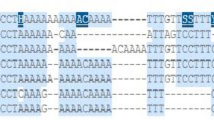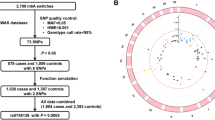Abstract
Exonuclease 1 (Exo 1) is an important nuclease involved in mismatch repair system that contributes to maintain genomic stability, to modulate DNA recombination, and to mediate cell cycle arrest. A guanine (G)/adenine (A) common single nucleotide polymorphism at first position of codon 589 in Exo 1 gene determines a glutamic acid (Glu, E) to lysine (Lys, K) (K589E) aminoacidic substitution which may alter cancer risk by influencing the activity of Exo 1 protein. Exo 1 K589E polymorphism has been studied in various cancers, but its association with hepatocellular carcinoma (HCC) has yet to be investigated. To determine the association of the Exo 1 K589E polymorphism with the risk of HCC development in a Turkish population, a hospital-based case–control study was designed consisting of 224 subjects with HCC and 224 cancer-free control subjects matched for age, gender, smoking and alcohol status. The genotype frequency of the Exo 1 K589E polymorphism was determined by using a polymerase chain reaction–restriction fragment length polymorphism assay. Our data shows that the Lys/Lys genotype of the Exo 1 K589E polymorphism is associated with increased risk of HCC development in this Turkish population [odds ratio (OR) = 2.15, 95% confidence interval (CI): 1.13–4.09, P = 0.02]. Furthermore, according to stratified analysis, a significant association was observed between the homozygote Lys/Lys genotype and HCC risk in the subgroups of male gender (OR = 2.67, 95% CI: 1.27–5.61, P = 0.009) and patients with non-viral-related HCC (OR = 3.14, 95% CI: 1.09–8.99, P = 0.03). Because our results suggest for the first time that the Lys/Lys homozygote genotype of Exo 1 K589E polymorphism may be a genetic susceptibility factor for HCC in the Turkish population, further independent studies are required to validate our findings in a larger series, as well as in patients of different ethnic origins.

Similar content being viewed by others
Abbreviations
- SNP:
-
Single nucleotide polymorphism
- HCC:
-
Hepatocellular carcinoma
- CI:
-
Confidence interval
- OR:
-
Odds ratio
References
Parkin DM, Bray F, Ferlay J, Pisani P (2005) Global cancer statistics, 2002. CA Cancer J Clin 55:74–108. doi:10.3322/canjclin.55.2.74
Farazi PA, DePinho RA (2006) Hepatocellular carcinoma pathogenesis: from genes to environment. Nat Rev Cancer 6:674–687. doi:10.1038/nrc1934
El-Serag HB, Rudolph KL (2007) Hepatocellular carcinoma: epidemiology and molecular carcinogenesis. Gastroenterology 132:2557–2576. doi:10.1053/j.gastro.2007.04.061
Llovet JM, Fuster J, Bruix J (2004) The Barcelona approach: diagnosis, staging, and treatment of hepatocellular carcinoma. Liver Transpl 10:115–120. doi:10.1002/lt.20034
Lodato F, Mazzella G, Festi D, Azzaroli F, Colecchia A, Roda E (2006) Hepatocellular carcinoma prevention: a worldwide emergence between the opulence of developed countries and the economic constraints of developing nations. World J Gastroenterol 12:7239–7249
Shimada M, Nakanishi M (2006) DNA damage checkpoints and cancer. J Mol Histol 37:253–260. doi:10.1007/s10735-006-9039-4
Bartkova J, Horejsí Z, Koed K, Krämer A, Tort F, Zieger K, Guldberg P, Sehested M, Nesland JM, Lukas C, Ørntoft T, Lukas J, Bartek J (2005) DNA damage response as a candidate anti-cancer barrier in early human tumorigenesis. Nature 434:864–870. doi:10.1038/nature03482
Gorgoulis VG, Vassiliou LV, Karakaidos P, Zacharatos P, Kotsinas A, Liloglou T, Venere M, Ditullio RA Jr, Kastrinakis NG, Levy B, Kletsas D, Yoneta A, Herlyn M, Kittas C, Halazonetis TD (2005) Activation of the DNA damage checkpoint and genomic instability in human precancerous lesions. Nature 434:907–913. doi:10.1038/nature03485
Iyer RR, Pluciennik A, Burdett V, Modrich PL (2006) DNA mismatch repair: functions and mechanisms. Chem Rev 106:302–323. doi:10.1021/cr0404794
Schmutte C, Marinescu RC, Sadoff MM, Guerrette S, Overhauser J, Fishel R (1998) Human exonuclease I interacts with the mismatch repair protein hMSH2. Cancer Res 58:4537–4542
Tishkoff DX, Amin NS, Viars CS, Arden KC, Kolodner RD (1998) Identification of a human gene encoding a homologue of Saccharomyces cerevisiae EXO1, an exonuclease implicated in mismatch repair and recombination. Cancer Res 58:5027–5031
Wilson DM III, Carney JP, Coleman MA, Adamson AW, Christensen M, Lamerdin JE (1998) Hex1: a new human Rad2 nuclease family member with homology to yeast exonuclease 1. Nucleic Acids Res 26:3762–3768. doi:10.1093/nar/26.16.3762
Jager AC, Rasmussen M, Bisgaard HC, Singh KK, Nielsen FC, Rasmussen LJ (2001) HNPCC mutations in the human DNA mismatch repair gene hMLH1 influence assembly of hMutLa and hMLH1–hEXO1 complexes. Oncogene 20:3590–3595
Rasmussen LJ, Rasmussen M, Lee BI (2000) Identification of factors interacting with hMSH2 in the fetal liver utilizing the yeast two-hybrid system. In vivo interaction through the C-terminal domains of hEXO1 and hMSH2 and comparative expression analysis. Mutat Res 460:41–52. doi:10.1016/S0921-8777(00)00012-4
Schmutte C, Sadoff MM, Shim KS, Acharya S, Fishel R (2001) The interaction of DNA mismatch repair proteins with human exonuclease I. J Biol Chem 276:33011–33018
Tishkoff DX, Boerger AL, Bertrand P (1997) Identification and characterization of Saccharomyces cerevisiae EXO1, a gene encoding an exonuclease that interacts with MSH2. Proc Natl Acad Sci USA 94:7487–7492
Tran PT, Simon JA, Liskay RM (2001) Interactions of Exo1p with components of MutLa in Saccharomyces cerevisiae. Proc Natl Acad Sci USA 98:9760–9765. doi:10.1073/pnas.161175998
Tran PT, Erdeniz N, Symington LS, Liskay RM (2004) EXO1-A multi-tasking eukaryotic nuclease. DNA Repair (Amst) 3:1549–1559. doi:10.1016/j.dnarep.2004.05.015
Wei K, Clark AB, Wong E, Kane MF, Mazur DJ, Parris T, Kolas NK, Russell R, Hou H Jr, Kneitz B, Yang G, Kunkel TA, Kolodner RD, Cohen PE, Edelmann W (2003) Inactivation of exonuclease 1 in mice results in DNA mismatch repair defects, increased cancer susceptibility, and male and female sterility. Genes Dev 17:603–614. doi:10.1101/gad.1060603
Jin G, Wang H, Hu Z, Liu H, Sun W, Ma H, Chen D, Miao R, Tian T, Jin L, Wei Q, Huang W, Lu D, Shen H (2008) Potentially functional polymorphisms of EXO1 and risk of lung cancer in a Chinese population: a case-control analysis. Lung Cancer 60:340–346. doi:10.1016/j.lungcan.2007.11.003
Hsu NY, Wang HC, Wang CH, Chiu CF, Tseng HC, Liang SY, Tsai CW, Lin CC, Bau DT (2009) Lung cancer susceptibility and genetic polymorphisms of Exo1 gene in Taiwan. Anticancer Res 29:725–730
Zienolddiny S, Campa D, Lind H, Ryberg D, Skaug V, Stangeland L, Phillips DH, Canzian F, Haugen A (2006) Polymorphisms of DNA repair genes and risk of non-small cell lung cancer. Carcinogenesis 27:560–567. doi:10.1093/carcin/bgi232
Wang HC, Chiu CF, Tsai RY, Kuo YS, Chen HS, Wang RF, Tsai CW, Chang CH, Lin CC, Bau DT (2009) Association of genetic polymorphisms of EXO1 gene with risk of breast cancer in Taiwan. Anticancer Res 29:3897–3901
Bau DT, Wang HC, Liu CS, Chang CL, Chiang SY, Wang RF, Tsai CW, Lo YL, Hsiung CA, Lin CC, Huang CY (2009) Single-nucleotide polymorphism of the Exo1 gene: association with gastric cancer susceptibility and interaction with smoking in Taiwan. Chin J Physiol 52:411–418
Tsai MH, Tseng HC, Liu CS, Chang CL, Tsai CW, Tsou YA, Wang RF, Lin CC, Wang HC, Chiu CF, Bau DT (2009) Interaction of Exo1 genotypes and smoking habit in oral cancer in Taiwan. Oral Oncol 45(9):e90–e94. doi:10.1016/j.oraloncology.2009.03.01.1
Chang JS, Yeh RF, Wiencke JK, Wiemels JL, Smirnov I, Pico AR, Tihan T, Patoka J, Miike R, Sison JD, Rice T, Wrensch MR (2008) Pathway analysis of single-nucleotide polymorphisms potentially associated with glioblastoma multiforme susceptibility using random forests. Cancer Epidemiol Biomark Prev 17:1368–1373. doi:10.1158/1055-9965.EPI-07-2830
Hung RJ, Hall J, Brennan P, Boffetta P (2005) Genetic polymorphisms in the base excision repair pathway and cancer risk: a HuGE review. Am J Epidemiol 162:925–942. doi:10.1093/aje/kwi318
Kirk BW, Feinsod M, Favis R, Kliman RM, Barany F (2002) Single nucleotide polymorphism seeking long term association with complex disease. Nucleic Acids Res 30:3295–3311. doi:10.1093/nar/gkf466
Akkız H, Bayram S, Bekar A, Akgöllü E, Ülger Y (2011) Functional polymorphisms of cyclooxygenase-2 gene and risk for hepatocellular carcinoma. Mol Cell Biochem 347:201–208. doi:10.1007/s11010-010-0629-9
Akkız H, Bayram S, Bekar A, Akgöllü E, Ulger Y (2011) A functional polymorphism in pre-microRNA-196a-2 contributes to the susceptibility of hepatocellular carcinoma in a Turkish population: a case-control study. J Viral Hepat 18:e399–e407. doi:10.1111/j.1365-2893.2010.01414.x
Bruix J, Sherman M, Llovet JM, Beaugrand M, Lencioni R, Burroughs AK, Christensen E, Pagliaro L, Colombo M, Rodés J (2001) Clinical management of hepatocellular carcinoma. Conclusions of the Barcelona-2000 EASL conference. European Association for the Study of the Liver. J Hepatol 35:421–430
Tsai JF, Chang WY, Jeng JE, Ho MS, Lin ZY, Tsai JH (1994) Hepatitis B and C virus infection as risk factors for liver cirrhosis and cirrhotic hepatocellular carcinoma: a case-control study. Liver 14:98–102
Pugh RN, Murray-Lyon IM, Dawson JL, Pietroni MC, Williams R (1973) Transection of the esophagus for bleeding esophageal varices. Br J Surg 60:646–649
Bond GL, Levine AJ (2007) A single nucleotide polymorphism in the p53 pathway interacts with gender, environmental stresses and tumor genetics to influence cancer in humans. Oncogene 26:1317–1323. doi:10.1038/sj.onc.1210199
Naugler WE, Sakurai T, Kim S, Maeda S, Kim K, Elsharkawy AM, Karin M (2007) Gender disparity in liver cancer due to sex differences in MyD88-dependent IL-6 production. Science 317:121–124. doi:10.1126/science.1140485
International HapMap Project http://hapmap.ncbi.nlm.nih.gov/. Accessed 13 July 2011
Dong X, Jiao L, Li Y, Evans DB, Wang H, Hess KR, Abbruzzese JL, Li D (2009) Significant associations of mismatch repair gene polymorphisms with clinical outcome of pancreatic cancer. J Clin Oncol 27:1592–1599. doi:10.1200/JCO.2008.20.1111
Campbell PT, Curtin K, Ulrich CM, Samowitz WS, Bigler J, Velicer CM, Caan B, Potter JD, Slattery ML (2009) Mismatch repair polymorphisms and risk of colon cancer, tumour microsatellite instability and interactions with lifestyle factors. Gut 58:661–667. doi:10.1136/gut.2007.144220
Pan XM, Yang WZ, Xu GH, Bai P, Qin HJ, Zhang LS, Zhai XD, Tang M, Deng W, Zhang L, Gao LB (2011) The association between MLH1 −93 G>A polymorphism of DNA mismatch repair and cancer susceptibility: a meta-analysis. Mutagenesis 26:667–673. doi:10.1093/mutage/ger032
Ito E, Yanagisawa Y, Iwahashi Y, Suzuki Y, Nagasaki H, Akiyama Y, Sugano S, Yuasa Y, Maruyama K (1999) A core promoter and a frequent single-nucleotide polymorphism of the mismatch repair gene hMLH1. Biochem Biophys Res Commun 256:488–494
Chen CC, Yang SY, Liu CJ, Lin CL, Liaw YF, Lin SM, Lee SD, Chen PJ, Chen CJ, Yu MW (2005) Association of cytokine and DNA repair gene polymorphisms with hepatitis B-related hepatocellular carcinoma. Int J Epidemiol 34:1310–1318. doi:10.1093/ije/dyi191
Liberti SE, Rasmussen LJ (2004) Is hEXO1 a cancer predisposing gene? Mol Cancer Res 2:427–432
Marti TM, Kunz C, Fleck O (2002) DNA mismatch repair and mutation avoidance pathways. J Cell Physiol 191:28–41. doi:10.1002/jcp.10077
Modrich P, Lahue R (1996) Mismatch repair in replication fidelity, genetic recombination, and cancer biology. Annu Rev Biochem 65:101–133. doi:10.1146/annurev.bi.65.070196.000533
Bolderson E, Richard DJ, Edelmann W, Khanna KK (2009) Involvement of Exo1b in DNA damage-induced apoptosis. Nucleic Acids Res 37:3452–3463. doi:10.1093/nar/gkp194
Klapacz J, Meira LB, Luchetti DG, Calvo JA, Bronson RT, Edelmann W, Samson LD (2009) O6-methylguanine-induced cell death involves exonuclease 1 as well as DNA mismatch recognition in vivo. Proc Natl Acad Sci USA 106:576–581. doi:10.1073/pnas.0811991106
Matakidou A, el Galta R, Webb EL, Rudd MF, Bridle H, GELCAPS Consortium, Eisen T, Houlston RS (2007) Genetic variation in the DNA repair genes is predictive of outcome in lung cancer. Hum Mol Genet 16:2333–2340. doi:10.1093/hmg/ddm190
Acknowledgments
The authors thank all the subjects who participated in this study. This work was supported by Adıyaman University Research Fund SYOBAP2011/0003.
Conflict of interest
All of the authors declare that there are no conflicts of interest.
Author information
Authors and Affiliations
Corresponding author
Rights and permissions
About this article
Cite this article
Bayram, S., Akkız, H., Bekar, A. et al. The significance of Exonuclease 1 K589E polymorphism on hepatocellular carcinoma susceptibility in the Turkish population: a case–control study. Mol Biol Rep 39, 5943–5951 (2012). https://doi.org/10.1007/s11033-011-1406-x
Received:
Accepted:
Published:
Issue Date:
DOI: https://doi.org/10.1007/s11033-011-1406-x




